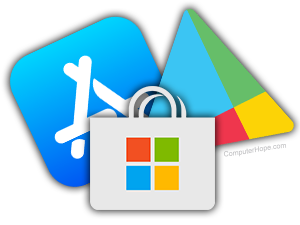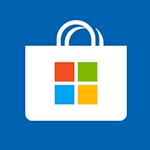App store

In general, an app store is an app that helps a user find software and install it on their computer or mobile device. It's a collection of free or commercial software and games approved for use on your device. You can browse, purchase, download, install, and update software through your device's app store.
App store was featured as a top term of 2011.
Benefits of using an app store
The software available on an app store is officially approved by the store operator. For instance, Apple inspects all software on the macOS and iOS App Stores, and Google inspects all software on the Play Store. The code of each app is reviewed to make sure it doesn't contain malware or viruses, and conforms to other guidelines for the user's device. The software is then digitally signed by the store operator to prevent it from being altered without the operator's knowledge and approval.
Other benefits of app stores
- Convenience - Users can search for new software in one familiar place on their device.
- Trust - Instead of needing to trust a wide array of software vendors, trust can be placed in a single entity (the store operator).
- Consistent experience - Because software must conform to device guidelines, separate apps have a greater consistency of interface and user experience. The user is already familiar with the general way the software looks, feels, and operates.
- Easier updates - When an update is available for software installed from the app store, the store can notify the user. The user does not need to manually check for new updates. If multiple updates are available, they can be installed by the app store all at once.
macOS App Store (Apple computer)

The macOS App Store was launched on January 6, 2011. It is part of macOS and can find, download, and install software for a Mac. The App Store is also used to install security updates and upgrade to newer versions of macOS.
On macOS computers, the App Store is located in the Applications folder and as a default icon on the dock.
The macOS App Store is closely integrated with a macOS feature called Gatekeeper, which verifies the digital signature of all apps downloaded from the Internet. For information about changing Gatekeeper settings, see Changing Gatekeeper settings in macOS.
iOS App Store (Apple iPad and iPhone)

The iOS App Store provides software downloads for the iPad and iPhone. It was launched on July 10, 2008. Unlike in macOS, the iOS App Store is not used for updating the iOS system, and cannot be configured to lower security settings. The only way to install software on an iOS device without using the App Store is to jailbreak the device, which voids its warranty.
On iOS devices, the App Store is on the home screen. It is a core part of iOS and cannot be removed.
How to install an app on an iPhone or iPad.
Google Play Store (Android tablet and smartphone)
The Google Play Store is an app store provided by Google for Android devices, the Chrome web browser, and ChromeOS computers. It was launched on October 22, 2008, as "Android Market." It was later integrated with two other Google services, Google Music and Google eBookstore, to create Google Play.
Unlike other App Stores, Google Play allows users to purchase digital music and e-books.
On most Android devices, the Play Store is available on the home screen.
On the web, you can visit the Google Play Store website.
Microsoft Store (Microsoft PC)

The Microsoft Store is an app store for Microsoft Windows. It was also available on the Windows Phone before Microsoft discontinued the platform in July 2017.
In both Windows 10 and Windows 11, to access the Microsoft Store, press the Windows key, type Microsoft Store, and press Enter. Users can also find the Microsoft Store in the Start menu under the "M" section of installed programs.
The Microsoft Store does not offer updates to the Windows operating system. To update Windows, use Windows Update instead.
App, Developer, Digital distribution, Download, Google Play, Install, Internet, Phone terms, Smartphone
